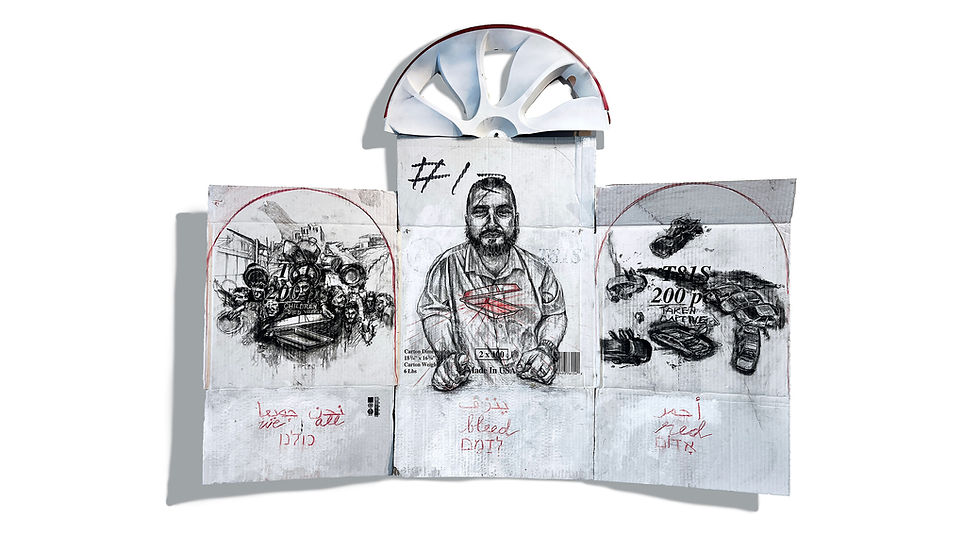New Era, New Energy: Fullerton Museum Center Reopens After Major Renovation
- Joel Beers

- 6 hours ago
- 7 min read
A long-awaited grant is funding the Fullerton Museum Center’s renovation, which salutes its past and points to its future.

If a standing ovation is in order this Saturday, Nov. 22, to celebrate the reopening of the Fullerton Museum Center, you can count out Executive Director Elvia Rubalcava. For the past year, she has been largely confined to a mobility scooter due to a foot injury and complications from a surgery that require a second surgery.
But that hasn’t prevented Rubalcava or the museum’s staff, volunteers and board members from kicking ass. 2025 has seen the museum’s most successful exhibition in its history and its most significant upgrades, thanks to a long-awaited $4.5 million state grant for capital improvements.

“It’s great having this grant and this is all about modernizing the center while also acknowledging the building’s past,” Rubalcava said. “But we also want to make sure that we walk away from this taking every opportunity to use (the money) wisely to help prepare for the future.”
The museum’s public rooms will be introduced to visitors for the first time Saturday, with three separate openings and one one-day opening. In the main gallery is a retrospective of prolific graphic designer John Van Hamersveld, whose imprint on pop culture ranges from the iconic poster for the surfing film “Endless Summer” (1966) to album covers like The Beatles’ “Magical Mystery Tour” and psychedelic images of Jimi Hendrix.
There will also be openings in the museum’s permanent Leo Fender Gallery, focusing on longtime Fender collaborator Charlie Davis, and the smaller James F. Rainey Gallery will present work by Los Angeles and Inland Empire artist Cesar Aguiar, aka Cezzart. Finally, there will be a one-day presentation of 35 local artists who created designs for unfinished Fender guitar bodies, five of which will be selected to become playable, professionally crafted instruments.
The exhibits will all take place in a building that has been upgraded in many ways, including enhanced lighting, restored windows and moveable walls in its galleries, renovated conference and classroom spaces, a redesigned lobby, and even the conversion of a former storage closet into a small café. Future improvements to the museum’s vaults and roof are pending.
Back on its feet
The renovation will enhance the experience for patrons and help the museum’s bottom line, with officials already reporting a sharp uptick in rentals. That’s not to imply the museum is basking in a full victory lap; it’s more the kind where you’re still catching your breath and eyeing the next turn.
But after a series of shocks that nearly KO’d the FMC, the upgrades have put it on its steadiest footing in years.
The first shock came in March 2020, with a pandemic-related shutdown. Three months later, the Fullerton City Council unanimously voted to cut its annual $300,000 funding for the museum.
In June 2021, the city council approved a museum request for $150,000, allowing it to open three days a week. But when the museum’s board finally got the keys back, it found a building that hadn’t been maintained.
Since reopening in July 2021, Rubalcava and a skeleton staff have run the museum, presenting touring and in-house exhibitions, a plethora of community events ranging from children’s education programming and poetry and music open mics, opening its doors to local theater companies and musicians, rentals, and, of course, its beer garden, which anchors the city’s farmers’ market from April through September.
In June 2023, FMC learned it had received a $4.5 million state grant for capital improvements – but it would take nearly two years to see any of that money. Community support, smaller grants and private donations kept the museum alive during the long wait, Yet, somehow 2025 still delivered the museum’s most successful exhibit – a history of O.C. punk rock music, which garnered about $80,000 in ticket sales, nearly twice the museum’s annual goal of $40,000–$50,000, Rubalcava said.
PHOTO 1: The exterior of the Fullerton Museum Center. Screenshot courtesy of Google Street View/Map data: Google, Maxar Technologies PHOTO 2: As part of the museum's renovation, the main galleries walls have been strengthened and several are moveable, meaning a far more flexible exhibition space in the future. PHOTO 3: As part of its $4.5 million renovation, the museum is restoring windows in its galleries installed in 1942 but covered since 1985. Photos courtesy of Fullerton Museum Center
Historical legacy meets modern upgrades
The state grant is tied to capital improvements, and the renovation is modernizing the building while preserving its historical legacy. The site originally opened in 1907 as the city’s library on the corner of Pomona and Wilshire avenues in downtown Fullerton. That building was replaced by a Spanish Colonial-designed building that opened in 1941. It remained a library until 1973, when the Museum of North Orange County took over. Following renovations, the building reopened in 1985 as the Fullerton Museum Center.
Restoring some sense of the building’s history as a library was important to Andrea Freeman, a longtime city resident whose interior design company, Authentik, is overseeing the non-gallery upgrades, including the lobby, conference room and classroom spaces.
The lobby and gift shop were transformed to reflect the museum’s earlier era as a library, featuring recessed shelves, mid-century furnishings like avocado-green chairs, and a newly revealed (but non-functional) fireplace.
The conference room now has lockable archival cabinets that slide away when the space is used as an extra gallery. A former storage closet was reborn as a tiny café with a service window that will eventually open onto the patio and beer garden. The arts education room got a new name, after longtime educational coordinator Aimee Aul, and a full glow-up that makes it more suitable for hands-on kids classes as well as providing possible space for outside artists to use as a working studio. The 1940s Wilshire Room performing space now sports subtle Art Deco touches and a fresh mural.
Local connections
Freeman has a personal connection to the museum. Growing up in Fullerton, she said, she “was a little kid going to the museum, and I know this is more than a museum. It’s a community center, so being able to have a stamp on it is really cool.”
Rubalcava said local connections were essential to her because while the FMC is a museum, it’s also an integral part of the local Fullerton and greater O.C. community. Working with local people, including Freeman and the fabricators building the current exhibits, professionals who have worked on exhibits at the Bowers Museum, as well as the staff and volunteers, is essential to her.
“What I loved about this whole project and process is how invested everyone was in this historic building and how appreciative they were to work on this project. Just the care and passion behind everything they created. They went above and beyond because they care about it.”
PHOTO 1: Artist John van Hamersveld. A retrospective of his work at the Fullerton Museum Center contains album covers, poster illustrations, prints, digital compositions and photomurals of public works that he has designed over his prolific 60-year career. PHOTO 2: Van Hamersveld's poster promoting a Jimi Hendrix concert at the Shrine Auditorium in 1968 is a masterpiece of psychedelic art. PHOTO 3: Van Hamersveld created the iconic poster for the 1966 film "The Endless Summer" in 1964, while he was still a student at the Art Center College of Design in Pasadena. Photo courtesy of Fullerton Museum Center
Gallery Improvements
Curator Georgette Collard, who started at the museum as an intern and was named curator last year, couldn’t be more excited about the transformation of the museum’s main gallery. Upgrades include moveable, sturdier walls, new lighting and the restoration of previously covered windows that allow far more natural light, all of which enhance patron experience as well as contributing to a renewed sense of pride among employees and volunteers, she said.
“Before the layout was fixed but now with the removable walls it gives us more flexibility to change the layout, like maybe accommodating larger pieces that we couldn’t do before,” she said. “It makes the museum more spacious, the walls are sturdier but also lighter, and you can really see the difference.”
The current exhibit won’t fully showcase the new flexibility as it was originally scheduled before the renovations. But it fits the space perfectly, featuring drawings and prints that hang comfortably on the walls. It’s the debut of a touring exhibition co-curated by the artist’s wife, Alida Post, which provides more of a behind-the-art look, Collard said.
“You don’t often see all the steps that a graphic designer or illustrator takes in creating, you just see the final product,” she said. “So, with her guidance, we’re able to show the sketches and drawings that lead to” the finished piece.
Eye on the Future
All these improvements are part of a larger strategy for sustainability, which is about keeping the FMC thriving without constantly patching the budget. Rubalcava is constantly thinking about and implementing revenue streams such as facility rentals, a corporate membership program and expanding its educational sphere, such as a still-in-the-talking stage community education program in partnership with Southern California Edison to reach communities that traditionally don’t engage with museums.
“We can’t be an island. We need to work with local nonprofit and businesses, community leaders, and artists,” she said. “We’re investing back into the museum, respecting artists, and creating spaces that are theirs as much as ours.”
The renovation, which ties the building’s past to its present, is also about the future.
“There’s no going back for us,” Rubalcava said. The renovation “is also about what this museum will look like 50 or 100 years from now when we’re long gone. We want to leave a mark in the arts world, and we’re doing that, step by step.”
Opening Night at the Fullerton Museum Center
Four exhibits will be unveiled on Nov. 22.
‘Amplified Creations’
When: 6-9 p.m., Nov. 22 (one night only)
‘Current Events of Cezzart’
When: Nov. 22-Jan. 3, 2026
‘Crazy World Ain’t It: The Art of John Van Hamersveld’
When: Nov. 22- Feb. 22, 2026
‘A Man Named Charlie: Fender’s Unsung Hero’
When: Nov. 22-Dec. 1, 2026
Where: Fullerton Museum Center, 301 N. Pomona Ave, Fullerton
Hours: Noon-4 p.m. Wednesday and Sunday, noon-8:30 p.m. Thursday, noon-6 p.m.
Cost: $10 (includes all exhibits)
Information: fullertonmuseum.com




























_gif.gif)



%20(1)_gif.gif)